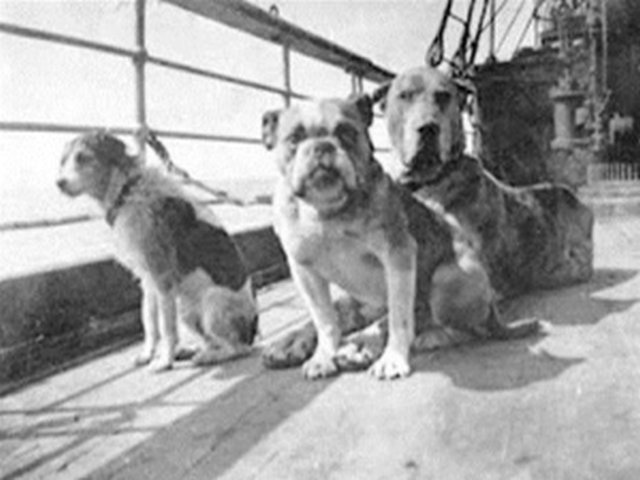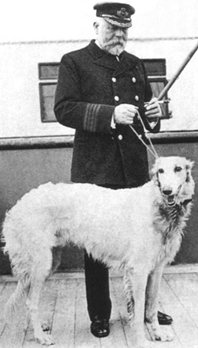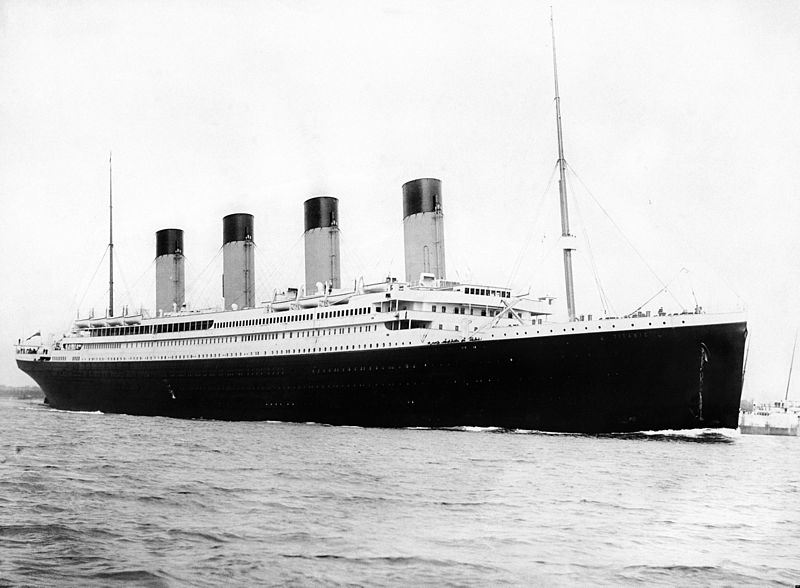Generally when one thinks of the Titanic sinking, they think of all of the lives that were lost in the tragic accident. However, not many realize that there were also dogs on the ship the night it struck the iceberg. Twelve dogs were known to have been on the ship, however many historians believe there could have been way more than those on board that day, because dogs were still listed as cargo on the ship’s records and many of the details have been lost.
Of the twelve confirmed dogs, only three survived. They were all small dogs – two Pomeranians and one Pekingese. They were easy to hide inside a blanket or coat while being carried to the lifeboats. If those dogs had been caught, they probably would not have been allowed on the boats.
One of the dogs known to have been on board was Captain Smith’s Wolfhound named Ben. Ben only stayed one night on the ship before it left the dock. Before leaving, Ben was returned to Smith’s daughter to look after while Smith was gone.
In one of the records, passenger 50-year-old Ann Elizabeth Isham was noticed by many to have visited her Great Dane in the ship’s kennels daily. Luckily for Isham, she was one of the few who managed to get a seat on a lifeboat. However, she was told that her dog was too large to join her in the boat. At that point, she chose to leave her seat in the boat and to die with her dog. Her body was found a few days later in the icy waters, clutching her dog.

Back then, only first class passengers were allowed to bring dogs on board. Some of the passengers included: Helen Bishop and her toy poodle named Frou-Frou, millionaire John Jacob Astor and his Airedale named Kitty, Robert Daniel and his French bulldog Gamin de Pycombe, and Harry Anderson was joined by his Chow-Chow. William Carter and his family brought two dogs – a King Charles Spaniel and an Airedale.
For the people who made it out on lifeboats, they had some tough decisions to make. Margaret Hays’ Pomeranian lived until 1919 after they both escaped the sinking ship. Henry and Myra Harper had brought their Pekingese on the lifeboat, whereas poor Helen Bishop had to make the dreadful decision to leave her Frou-Frou onboard in her cabin. It is hard to imagine how terrible making that decision was. The poor dog knew that it was a stressful time and tried keeping her owner in the cabin with her by pulling the lady’s dress, tearing it at the seam.

After everyone on the ship knew that it was going down, someone had let the dogs out of their kennels, resulting in even more chaos. Many people in the rescue groups recall seeing many people and occasionally a dog that did not make it. Robert W. Daniel’s bulldog Gamin de Pycombe was last seen in the water trying to swim away after the ship went down.

Along with the dogs aboard the ship, the Titanic had its very own cat named Jenny. She became known as the ship’s little mascot for catching all of the mice and rats that were living on it. Thankfully, she had given birth just a week before the Titanic had set sail, so she had been moved to the Titanic’s sister ship, the Olympic.
She had originally lived in the galley where the staff had fed her and her kittens scraps from the kitchen. One of the employees, Violet Jessop, had written that Jenny particularly took a liking to the scullion, Jim.
There were birds on board as well. Ella Holmes White from New York had brought four roosters and hens which were kept near the dog kennels. She had imported them from France and probably intended to keep them as poultry stock at her home. Another passenger on board supposedly had 30 cockerels aboard, and Elizabeth Ramel Nye brought a yellow canary.
Like any traveller today, all animals had to have their own ticket. Even the animals as small as the canary needed to pay; it cost 25 cents to have them on board with their owners.
And any ship traveller or employee would know that all of them generally have a few rats and mice living in parts of it. One rat decided to appear in the middle of dinner on one of the nights. A majority of the women burst into tears while the men at dinner unsuccessfully tried catching it.
